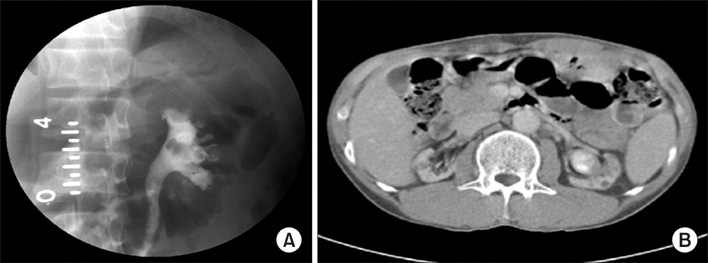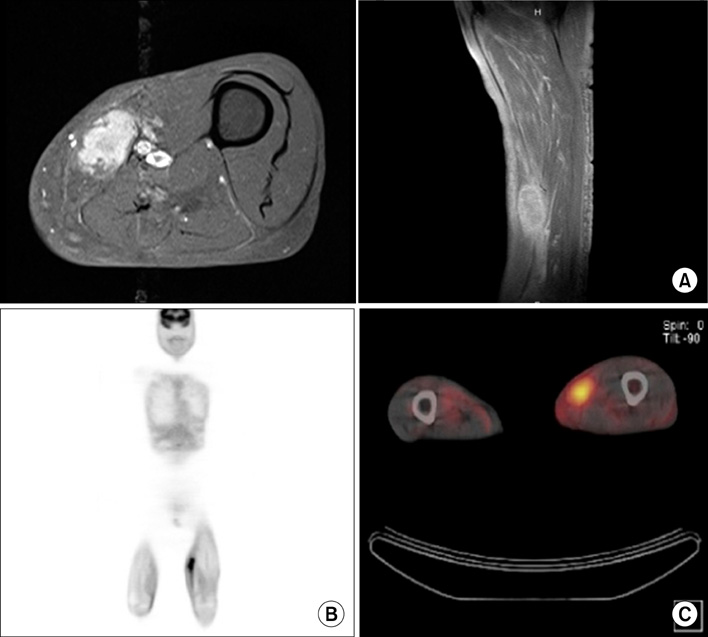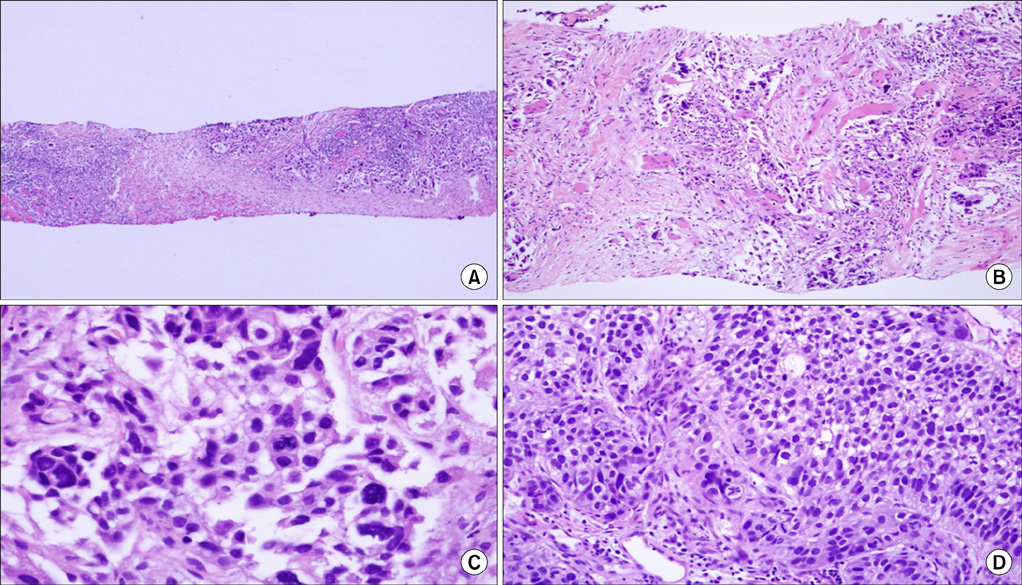Korean J Urol.
2012 Jan;53(1):63-66. 10.4111/kju.2012.53.1.63.
Skeletal Muscle Metastases from Urothelial Cell Carcinoma
- Affiliations
-
- 1Department of Urology, Soonchunhyang University College of Medicine, Seoul, Korea. yssong@schmc.ac.kr
- 2Department of Pathology, Soonchunhyang University College of Medicine, Seoul, Korea.
- KMID: 1988827
- DOI: http://doi.org/10.4111/kju.2012.53.1.63
Abstract
- Hematogenous metastasis to skeletal muscle from urothelial carcinoma is extremely rare and metastatic disease to skeletal muscle tends to be found in people with advanced-stage neoplasm. We report in this paper a case of left sartorius muscle metastasis from urothelial cell carcinoma. A left nephroureterectomy with bladder cuff excision was performed and revealed a high-grade papillary transitional cell carcinoma (TCC) of the pelvis. And 6 month later, recurrent bladder cancer was found regular cystoscopy and then treated with transurethral resection of the bladder. After 6 times resection of bladder, an invasion into the bladder muscle layer was found. We recommended additional radical cystectomy to prevent the disease from advancing. However, the patient refused additional surgery. 6 month later, the patient complained of left thigh pain, so ultrasonography-guided biopsy of the nodular mass lesion in the left sartorius muscle was performed. The pathological analysis of the biopsy specimen revealed poorly differentiated metastatic urothelial carcinoma.
Keyword
MeSH Terms
Figure
Cited by 1 articles
-
Skeletal Muscle Metastases from Breast Cancer: Two Case Reports
Young Woo Kim, Kyung Jin Seo, Su Lim Lee, Ki Wook Kwon, Joon Hur, Ho Jung An, Yoon Ho Ko, Jeong Soo Kim, Hye Sung Won
J Breast Cancer. 2013;16(1):117-121. doi: 10.4048/jbc.2013.16.1.117.
Reference
-
1. Mulsow FW. Metastatic carcinoma of skeletal muscles. Arch Pathol. 1943. 35:112–114.2. Pickren JW. Weiss L, editor. Use and limitations of autopsy data. Fundamental aspects of metastasis Amsterdam. 1976. Amsterdam: North-Holland;377–384.3. Ekici S, Ozen H, Gedikoglu G, Aygün C. Skeletal Muscle Metastasis from Carcinoma of the Bladder. Scand J Urol Nephrol. 1999. 33:336–337.4. Pop D, Nadeemy AS, Venissac N, Guiraudet P, Otto J, Poudenx M, et al. Skeletal Muscle Metastasis from non-small cell lung cancer. J thorac Oncol. 2009. 4:1236–1241.5. Klune JR, Zuckerbraun B, Tsung A. Isolated skeletal muscle metastasis following successful treatment of laryngeal cancer: case report. Int Semin Surg Oncol. 2010. 7:1.6. Nabi G, Gupta NP, Gandhi D. Skeletal muscle metastasis from transitional cell carcinoma of the urinary bladder: Clinicoradiological features. Clin Radiol. 2003. 58:883–885.7. Di Giorgio A, Sammartino P, Cardini CL, Al Mansour M, Accarpio F, Sibio S, et al. Lung cancer and skeletal muscle metastase. Ann Thorac Surg. 2004. 78:709–711.
- Full Text Links
- Actions
-
Cited
- CITED
-
- Close
- Share
- Similar articles
-
- Multiple Skeletal Muscle Metastases of Renal Cell Carcinoma after Nephrectomy: Case Report
- Metastases to Skeletal Muscles from Non-Small Cell Lung Cancer Demonstrated by 18F-FDG PET/CT
- Multiple Skeletal Muscle Metastases in a Case of Transitional Cell Carcinoma of Bladder Detected by F-18 FDG PET/CT
- Metastatic Renal Cell Carcinoma to Unusual Locations: A Case Report
- Skeletal Muscle Metastasis and Elevated beta-HCG Level Secondary to Tongue Cancer: a Case Report and Review of Literature





